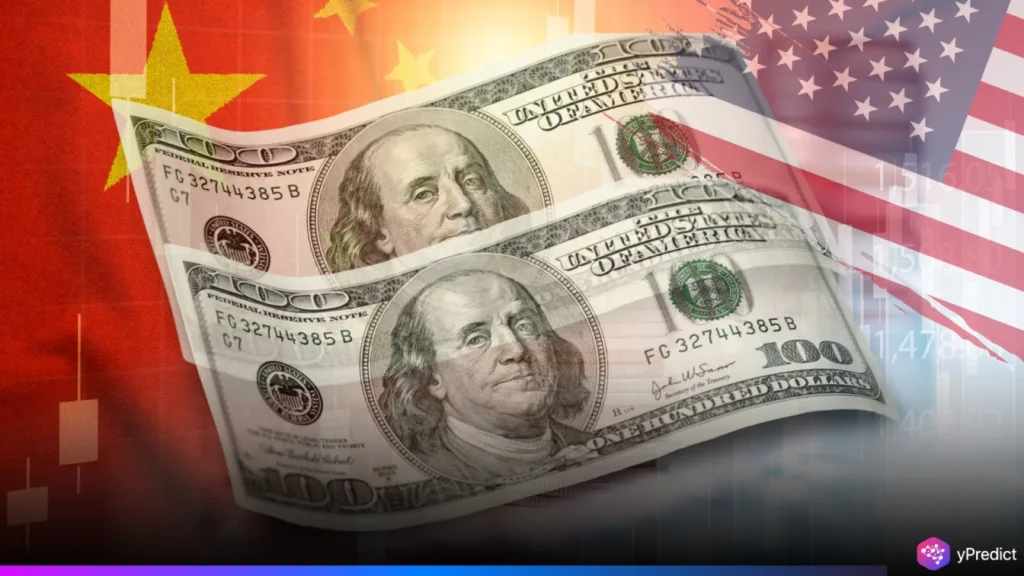
Global stocks rallied and the U.S. dollar gained strength on Tuesday as investors welcomed signs of progress in long-stalled U.S.-China trade talks. With both Washington and Beijing issuing cautiously optimistic statements after a new round of negotiations, markets reacted swiftly to the prospect of easing economic tensions between the world’s two largest economies.
The U.S. Dollar Index rose above 99.00 for the first time in over a month, while major indices across Asia, Europe, and North America saw broad-based gains. Energy and tech sectors led the rebound as optimism fueled renewed appetite for risk.
Investor Sentiment Rebounds on Constructive Dialogue
Reuters reported that Global share markets and the US dollar moved higher on Tuesday as fresh trade talks between Washington and Beijing entered their second day, raising cautious hopes for a thaw in tense bilateral relations. President Donald Trump characterized Monday’s early meetings positively, which boosted market optimism.
Senior US officials, including Treasury Secretary Scott Bessent, Commerce Secretary Howard Lutnick, and Trade Representative Jamieson Greer, continued negotiations in London with a Chinese group led by Vice Premier He Lifeng. The discussions aim to ease long-standing trade tensions that have hampered global supply chains, hindered economic growth, and raised investor concerns.
While investors welcomed signs of progress, analysts cautioned against overestimating the likelihood of a complete rollback of existing tariffs. Jonas Goltermann, Deputy Chief Markets Economist at Capital Economics, noted that markets may be reacting optimistically, but he expects U.S. tariffs on Chinese imports to remain elevated, potentially stabilizing at around 40%.
Despite continued trade concerns, global markets have remained robust. The MSCI All-Country World Index remained around all-time highs, as the dollar strengthened versus a basket of major currencies. In Europe, the STOXX 600 remained flat as investors moved their focus to pharmaceutical stocks following Health Secretary Robert F. Kennedy Jr.’s removal of a US vaccination advisory group. GSK shares fell, while Sanofi and Bavarian Nordic saw slight gains.
Stocks, Commodities React Positively Across the Board
In Asia, trading was mixed. Japan’s Nikkei 225 rose 0.32%, while the Topix index remained steady. South Korea’s Kospi continued its winning streak, but China’s CSI 300 dipped. The Hang Seng Index in Hong Kong remained steady, while Indian indices moved very little. Australia’s ASX 200 outperformed, setting a new record high.
Currency markets remained mostly stable. The dollar recovered some of its earlier losses and remained stable at 144.6 yen. The euro fell to $1.14, while the British pound fell to $1.3477, following poor job statistics from the UK. As the U.S. Dollar Index (DXY) rebounded to around 99.25, improved investor sentiment was evident in early European trading.
Yields on US Treasury bonds declined marginally, with the 10-year yield at around 4.45%. Investors are now focusing on crucial inflation data. The Consumer Price Index (CPI) for May, which is slated to be released on Wednesday, is likely to shed light on the impact of tariffs on household prices. Core CPI is expected to grow 2.9% year on year, with headline inflation at 2.5%. The Producer Price Index (PPI) is due the next day.
In commodity markets, oil prices rose as hopes for a breakthrough in U.S.-China trade relations buoyed demand expectations. Spot gold also gained slightly, trading at $3,332 per ounce.
U.S. stock futures fell during late Asian trading hours, despite President Trump’s assertion that discussions with China were moving smoothly. Wall Street’s major indices remained relatively stable overnight. The S&P 500 gained modestly, while the Nasdaq outperformed slightly and the Dow Jones Industrial Average remained practically flat.
Conclusion
As negotiations between the world’s two largest economies continue, markets remain sensitive to every development. A clearer picture may emerge in the days ahead, depending on trade concessions and upcoming inflation data, both of which could shape the monetary policy outlook and broader risk appetite.







